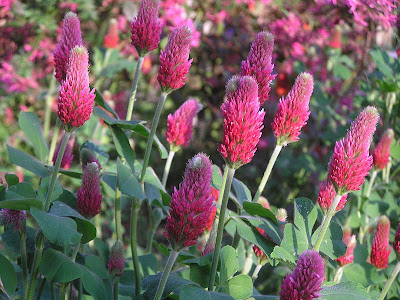All clovers are nitrogen fixing, when working with their Rhizobium bacterial friends. Might be a good idea to buy inoculated seeds, or buy inoculum. Depends on who you are reading.
Dutch white clover (Trifolium repens) is considered good for lawns. Dutch White clover is compact, keeping to a smaller size than most other clovers. It does not require watering, stays green longer than grasses do, and does well in poor soil. Dutch white clover improves the soil. This clover is a perennial legume. Dutch white clover is the type that grew on that ancient Illinois lawn of my boyhood years. It turns out that before herbicides and fertilizers, clover was included in high quality lawn seed.
The prompting issue for me, now, is to have lots of nectar production for honey bees. Of course. White clover is known as very bee friendly and produces a clear, excellent honey. Even without wanting to make honey, and even without beekeeping, however, the role of clover in soil conditioning and possibly attracting beneficial insects, and nurturing neighborhood bees, makes it a good addition to the lawn.
Part of the "rebranding" of white clover as a weed, was that bees were so attracted to it. The thought was that, to reduce risk for bee stings, we should eradicate clover in our lawns, keeping them toxic, environmentally wasteful and damaging, and unhealthy, but pure and pretty to some eyes. Multiple websites, especially grass seed companies, lawn care companies, and purveyors of fine chemical toxins, continue to promulgate the idea that clover is bad.
Red clover (Trifolium pratense) is regarded as marginal for honey bees, because the flower shape doesn't allow for good nectar retrieval by honey bees. Even so, they are beautiful to look at, and other beneficial insects can be attracted. Red clover is a short lived perennial, lasting 2 or 3 years. .
Red clover with bee. Apparently, honey bees may not get much nectar, but they can collect and use pollen. I don't know if some honey bees are better adapted than others, for red clover. Other types of bees might benefit. There are other choices, so it might be best to aim for those.
Ferdinand bee from the story of Ferdinand the Bull. My favorite book. And this image is inked onto my right calf. Looks like this bee is on a red clover.
If I plant in Spring, I may not get much, if any, bloom and nectar, for the white and crimson clovers. All in good time. The first year of beekeeping is about learning, and improving my environment for them in future years, and seeing what works, and what doesn't work.
White there are already occasional clover plants in the orchard and yard, they are rare. Probably due to nuking with "weed and feed". I want a more productive ground cover. Today I went around the little orchard area and lawns, with a garden rake and packets of white clover seeds. They can be obtained on Amazon and other places. I raked the mole hills smooth, spreading the soft soil around. Then I sprinkled Dutch White Clover seeds thinly on the prepared patches of soil, and raked a little more. The first frost is expected in one or two weeks. I don't know if these first seeds will survive and grow, If they don't, I'll replant in Spring. By then there will be more molehills, too. I will wait until other plants are growing, and if no clover germination then, I'll replant. I feel like I've made another step in the process of creating a more natural and useful area for honey and other bees, beneficial insects, the soil, and the plants and trees.





















